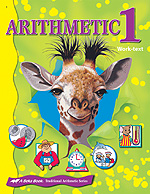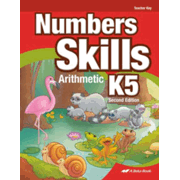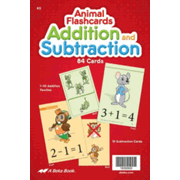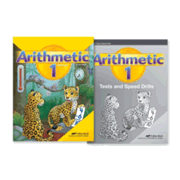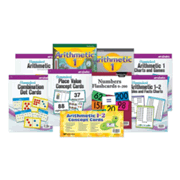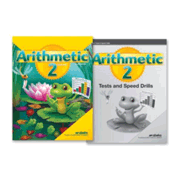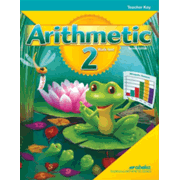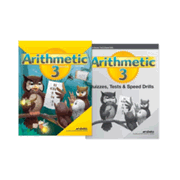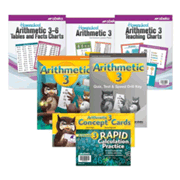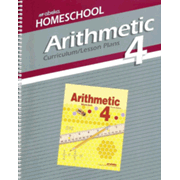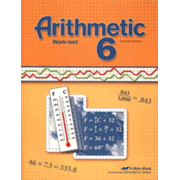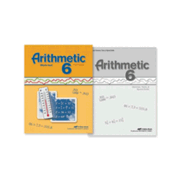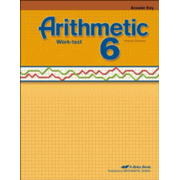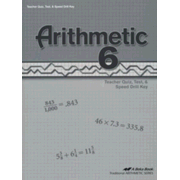(Note that this review is of the previous editions of these courses. I plan to update it in 2021.)
A Beka's Arithmetic series covers first grade through sixth grade. Courses for grades one through three have many similarities, so I will discuss them first.
Arithmetic 1 through Arithmetic 3
A Beka Arithmetic courses for grades 1 through 3 have student workbooks for each level that are dependent upon instruction presented by the teacher from the curriculum guide. All topics to be taught in each lesson are outlined in the curriculum guide, but all are not shown in the workbook. For each lesson, one page from the workbook is to be used in class with another used for independent work. The student test and speed drill booklet is intended to be used in daily lessons.
The program includes visual aids, games, and activities. (I suggest you purchase the curriculum/lesson plans without these aids, then go through it to figure out which of them you need, which you can make or find yourself, and which you need to order.) Student workbook are attractive with lots of illustrations and color.
The underlying educational approach is traditional, emphasizing rules, memorization of math facts, review, and drill. While some concepts are demonstrated with manipulatives, many new concepts are explained without demonstrations with manipulatives. For example, carrying is taught simply by talking about place value, rather than by demonstrating with objects how groups of 10 must be moved to the next column.
While the program is intended to be dependent upon the curriculum guide, I suspect some home educators will skip it, figuring they can teach the objectives listed in the teacher edition on their own. However, for the primary grades, every once in a while an activity relies on the teacher reading questions from the curriculum guide, and you won't know what is intended in those instances. Also, the bulk of each lesson is spent on review and drill activities, much of it directed from the curriculum guide. That means that you should purchase the curriculum/lesson plans guide along with the student worktext for the first three grade levels.
The separate teacher edition is optional for the primary grades. It has reduced pictures of student seatwork pages with answers overprinted. It also lists the lesson objectives and a few activities. However, answers are easy enough to figure out at the primary grade levels, and you will have enough activities following the curriculum guide.
Arithmetic 1 through Arithmetic 3 each require quite a bit of one-on-one presentation and use some manipulative demonstrations for teaching concepts, although not nearly as extensively in programs such as Math-U-See or RightStart Math.
Arithmetic 2 is more advanced than some other programs. It covers addition and subtraction with regrouping using four-digit numbers, multiplication and division with multipliers and divisors up through the number 5, and place value to the hundred thousands.
Arithmetic 3 covers multiplication by two-digit multipliers, short division up through divisors of 12, and adding and subtracting fractions and decimals. A set of charts is introduced at this level, and the same set of charts is used for grades three through six.
Arithmetic 4 through Arithmetic 6
The Arithmetic 4 worktext is a little more advanced than some other math programs. However, other math programs have moved up to A Beka's level of difficulty to meet the more challenging national math standards. The pace of Arithmetic 4 is similar to some others such as the Horizons Math 4. This text does an excellent job of reviewing previously taught concepts, and features periodic review lessons. Supplementary exercises at the back of the book can be used for additional work on particular concepts/skills.
The text includes some work with graphs and charts, but word problems and concept development are still weak in comparison to most other math programs. Supplementing with manipulatives and/or problem-solving books might be helpful to overcome these weaknesses.
Explanations within the student text should be adequate for average to above average students to do most of the work independently, which makes this a very efficient option for many families. The teacher key contains answers for the student text. A separate key is needed for the tests and speed drills. The Curriculum/Lesson Plans book is unnecessary for this level.
Arithmetic 5 is a challenging math program, strong on computation skill development. Expanded explanations with illustrations are an improvement over earlier editions. There are more story problems, previously one of the weak areas in A Beka math. In keeping with the math standards, there is more work with graphs. One lesson deals with probability, a topic included in the national standards, but not one that really needs to be addressed at this level of math. (A Beka deserves credit for limiting time spent on this topic.)
In addition to the above topics, Arithmetic 5 continues on through multiplication and division of both fractions and decimals. It reviews and expands coverage of place value, basic operations, Roman numerals (rarely taught in other programs!), measurement, graphs, and introductory geometry. At the end of the book are supplemental sections with more problems arranged by topics (e.g., multiplying fractions, story problems), homework "review" problems for every other lesson, and reference handbook.
It is still not a course that stresses conceptual understanding such as Math-U-See, but it should work well for students who are generally good at math and like to work independently. The worktext format is easy to work with—instruction and examples are built into the student book. Also, students appreciate not having to copy problems. You will probably want the Teacher's Edition as an answer key.
Arithmetic 6 teaches percents, fractions, decimals, proportions, prime factoring, and measurement along with basic geometry, algebraic equations, and some basic banking skills.
Summary
A test and speed drill booklet is available along with its companion answer key for all grade levels. Instructions as to when to use it are in the curriculum guide.
A Beka's Arithmetic curriculum best suits the compliant child who learns math fairly easily. It can work with other learners who need more hands-on experiences by supplementing with Cuisenaire® Rods or other manipulatives.




